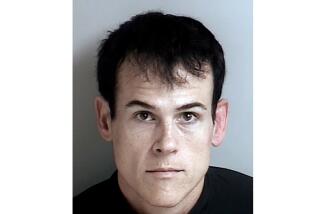Case Going to Trial in DNA Milestone
A crossing guard and a few classmates were the last ones known to have seen Sandra Astorga alive.
The 9-year-old was small for her age, weighing less than 50 pounds. She struggled with English but was trying her best to adapt to life in a new country, wearing a “Beverly Hills 90210” T-shirt as she walked to Roosevelt Elementary School in San Bernardino in January 1992.
Just over a month later, Sandra’s nude, decomposing body was discovered next to a nearby Little League field, covered by an oily tarp.
With few leads and no solid suspects, the murder investigation went cold until 1999, when the state Department of Justice’s DNA database flagged a suspect: Dean Eric Dunlap, a convicted child molester who had lived in the area.
Dunlap is scheduled to go on trial on murder, kidnapping and rape charges this week. That makes him the first defendant in San Bernardino County to face a possible death penalty because of evidence uncovered through the state’s DNA database.
“Sandra had never been heard. Now her rights and her voice have been given back to her,” said San Bernardino Police Sgt. Keith Prostler, who investigated the crime. “She will have her story heard in court.”
Dunlap’s name surfaced as state justice officials started mowing through a backlog of DNA evidence collected from unsolved cases and convicted felons. The DNA from semen on Sandra’s underwear was similar to DNA in a blood sample taken from Dunlap before he was released from state prison in 1996.
Statewide, prosecutors have relied on “cold hits” flagged by the state DNA database in at least five death penalty cases, including Dunlap’s, according to Department of Justice spokesman Nathan Barankin.
Los Angeles County Dist. Atty. Steve Cooley is expected to announce next month whether he will seek the death penalty against Rodney James Alcala, whose DNA has been implicated in the slayings of four Los Angeles County women in the 1970s. Alcala is awaiting retrial on his alleged 1979 abduction and killing of a Huntington Beach girl.
This month, preliminary DNA tests implicated California death row inmate Alfredo R. Prieto in three Virginia slayings in 1988, including that of a financial officer for the CIA.
Prieto was sentenced to death 14 years ago after he was convicted of raping and murdering a 15-year-old girl in Ontario. Prosecutors in Fairfax County, Va., are working with California law enforcement to determine whether he can be extradited to Virginia for trial.
In September 1992, Dunlap pleaded guilty to performing a lewd act on a child: While living in the San Bernardino County community of Muscoy, Dunlap pulled a knife on his girlfriend’s 13-year-old daughter and grabbed her breasts.
He was sentenced to eight years in prison, and as a condition of his parole he had to provide a DNA sample to the Department of Justice.
Dunlap was living in a high desert motel room when the similarity to Sandra’s crime scene DNA was established. During a videotaped interview with investigators, he said he had lived near Sandra when she disappeared -- but not much more than that, said his public defender, Teresa Snodgrass.
“He’s completely denied all of the charges against him,” Snodgrass said. “He’s always known the seriousness of the case against him.”
In the months before she was killed, Sandra came to the U.S. from Mexico with her mother, father and 11-year-old sister, San Bernardino police said. The family lived in a mobile home, and Sandra’s walk to school was less than a quarter-mile.
When Sandra didn’t return home from school the afternoon she disappeared, Sandra’s mother made panicked phone calls to the school and friends. Police were called that evening.
“In my six years in the crimes-against-children unit, I’d see cases where teens left home because they were mad at Mom and Dad, or others where little Jimmy had told a neighbor without his mom knowing that it was OK with his mom if he hung out with his friend there to play and eat cookies,” Prostler said. “Sandra’s was the only missing child’s case that ended bad.”
The evidence of sexual assault against Sandra prompted investigators to run comparative DNA tests with blood samples taken from registered sex offenders in the area.
Twenty of those tests were done from 1992 to 1998, said Cheryl Kersey, a San Bernardino County chief deputy district attorney. All came back negative.
“You’re running down each lead, hoping it will be the one, and then it becomes a dead end, and so is the next one and the next one,” said Prostler, who had been the lead investigator on the case.
Prostler said the case grated on him for years. At the time of the killing, Prostler had a daughter the same age.
“Sandra was an underdog,” Prostler said. “She was in a new country, dealing with a new culture, trying to learn the language and fit in to a place with a different style. Sandra’s family came to America seeking the American dream. But she never had a chance to fulfill that dream.”
Associated Press contributed to this report.
More to Read
Sign up for Essential California
The most important California stories and recommendations in your inbox every morning.
You may occasionally receive promotional content from the Los Angeles Times.











